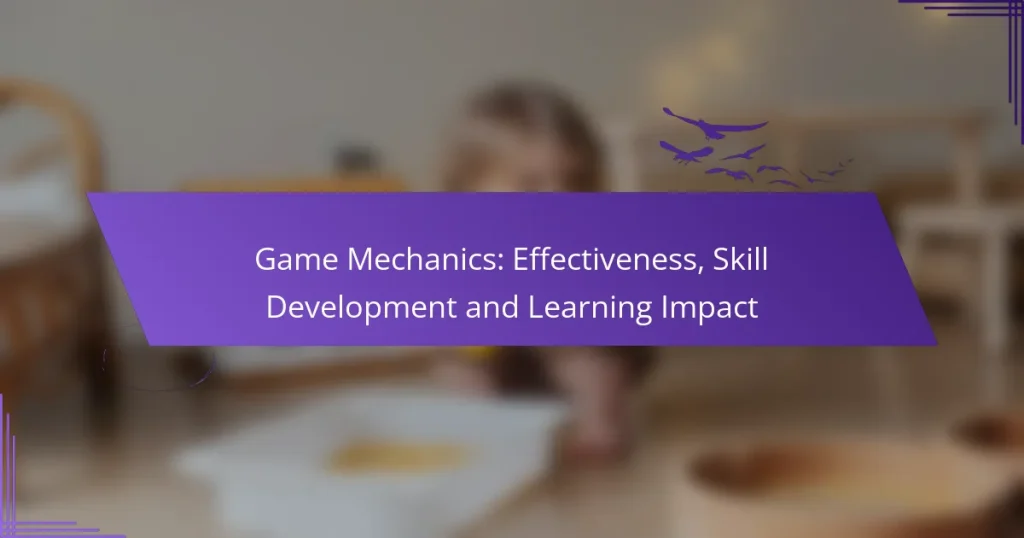Game mechanics play a crucial role in enhancing learning outcomes by fostering interactive environments that encourage active participation and skill acquisition. By integrating elements such as competition, rewards, and challenges, these mechanics not only promote deeper understanding but also facilitate the retention of knowledge, making them essential for effective skill development in educational contexts.
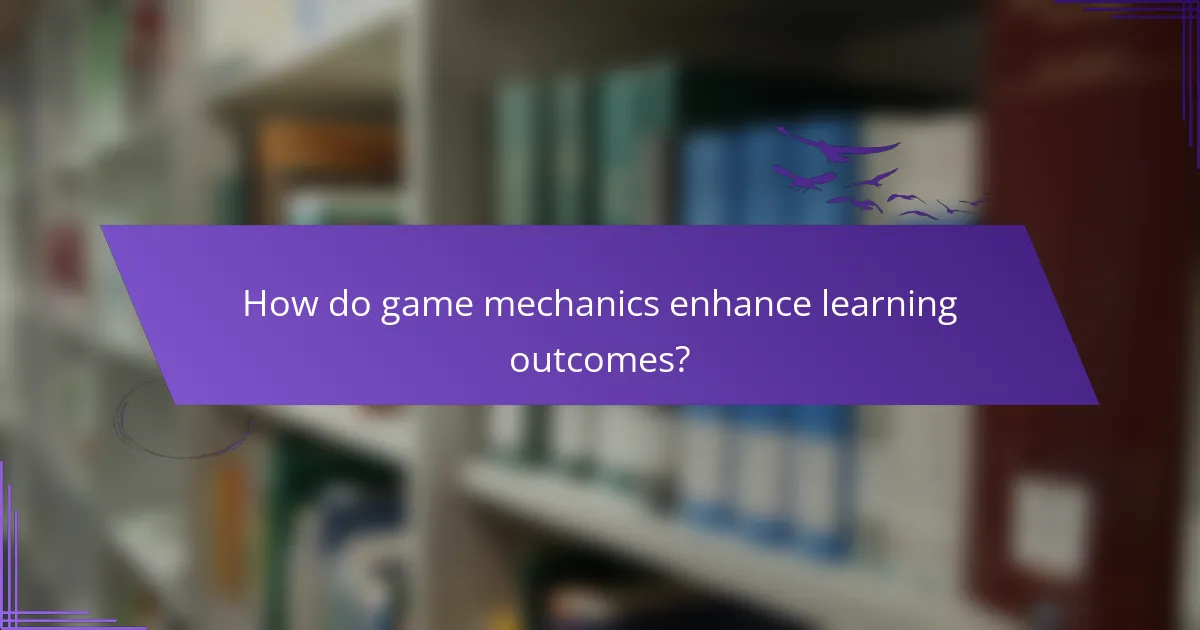
How do game mechanics enhance learning outcomes?
Game mechanics enhance learning outcomes by creating interactive and engaging environments that promote active participation and skill acquisition. These mechanics leverage competition, rewards, and challenges to facilitate deeper understanding and retention of knowledge.
Increased engagement through interactivity
Interactivity in game mechanics captivates learners by allowing them to actively participate rather than passively consume information. This engagement can lead to higher motivation levels, as players are often more willing to invest time and effort when they feel involved in the learning process.
Examples of interactive elements include decision-making scenarios, role-playing, and collaborative tasks. These features encourage learners to explore concepts in a hands-on manner, making the learning experience more memorable.
Improved retention via gamified assessments
Gamified assessments enhance retention by transforming traditional evaluation methods into engaging challenges. This approach can reduce anxiety associated with testing, allowing learners to focus on demonstrating their knowledge rather than merely recalling facts.
Incorporating elements like points, badges, and leaderboards can motivate learners to revisit and reinforce their understanding of the material. For instance, quizzes that reward progress with immediate feedback can significantly increase the likelihood of long-term retention.
Real-time feedback for skill development
Real-time feedback is a crucial aspect of game mechanics that supports skill development. By providing immediate insights into performance, learners can quickly identify areas for improvement and adjust their strategies accordingly.
Effective feedback mechanisms can include visual indicators of progress, hints for overcoming challenges, and constructive criticism. This timely information helps learners refine their skills, leading to more effective learning outcomes over time.
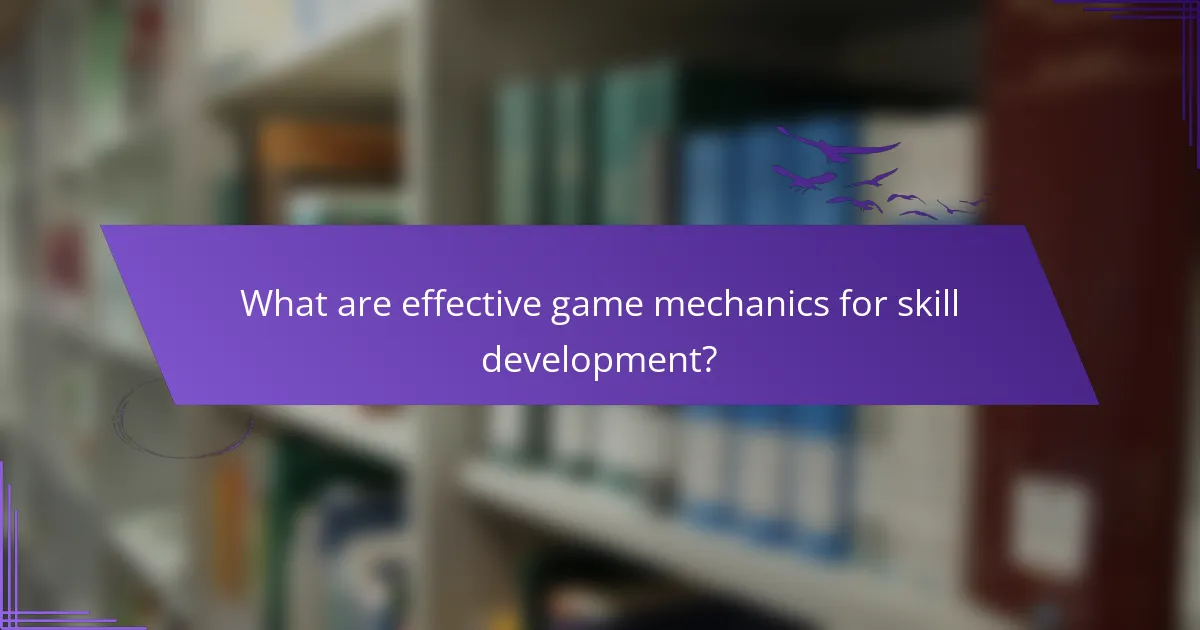
What are effective game mechanics for skill development?
Effective game mechanics for skill development include systems that promote mastery, motivate learners, and provide appropriate challenges. These mechanics are designed to enhance learning by engaging players in a structured way that encourages growth and retention of skills.
Progression systems for mastery
Progression systems help learners track their advancement and skills acquisition over time. These systems often include levels, ranks, or skill trees that unlock new abilities or content as players improve. For example, a role-playing game may allow players to gain experience points and level up, thereby enhancing their character’s skills and capabilities.
When designing progression systems, it’s important to ensure that they are clear and rewarding. Players should feel a sense of achievement as they progress, which can be facilitated by setting achievable milestones and providing feedback on their performance. A common pitfall is making progression too slow or too fast, which can lead to frustration or a lack of challenge.
Reward structures to motivate learners
Reward structures are essential for keeping learners engaged and motivated. These can include tangible rewards, such as in-game currency or items, as well as intangible rewards like achievements or recognition from peers. For instance, a game might offer bonus points for completing a task efficiently, encouraging players to refine their skills.
To create effective reward structures, consider varying the types of rewards and their frequency. Immediate rewards can reinforce learning, while long-term rewards can keep players invested in their progress. Avoid making rewards feel arbitrary; they should be tied directly to skill development to maintain relevance and motivation.
Challenge levels to match learner abilities
Challenge levels are critical for ensuring that players are appropriately engaged without becoming overwhelmed. Games should adapt to the skill level of the player, offering challenges that are neither too easy nor too difficult. For example, a puzzle game might adjust the complexity of puzzles based on the player’s previous performance.
To implement effective challenge levels, consider using adaptive difficulty settings or providing multiple difficulty options. This allows players to select a challenge that suits their current skill level. Be cautious of creating a one-size-fits-all approach, as individual learning curves can vary significantly, and failing to accommodate this can lead to disengagement.
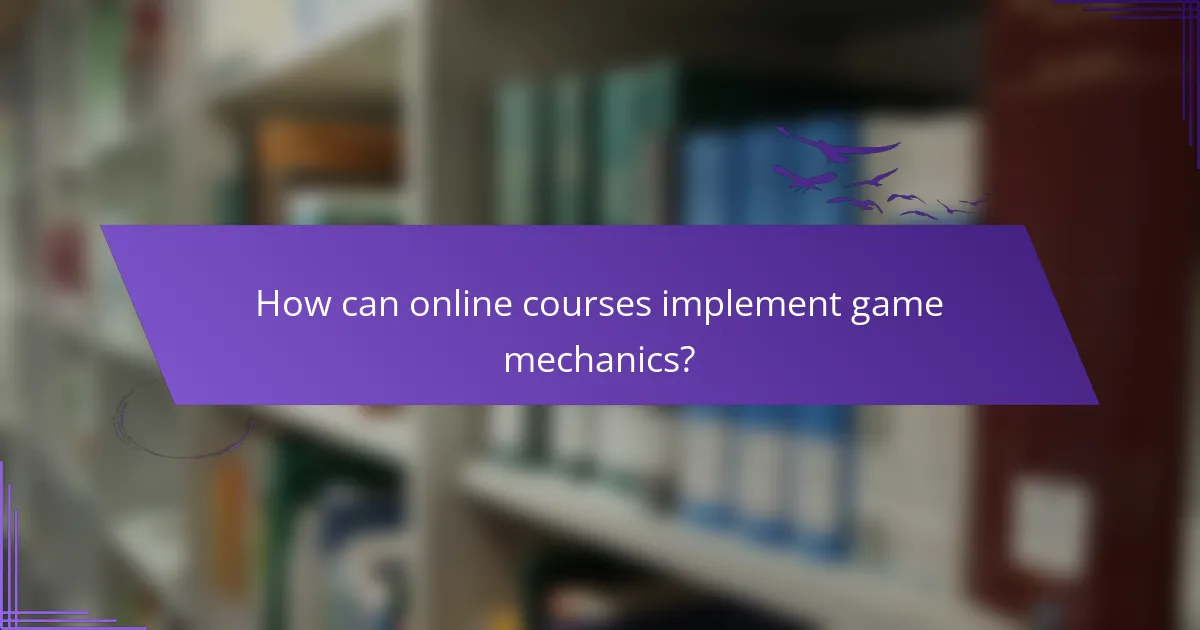
How can online courses implement game mechanics?
Online courses can effectively implement game mechanics by incorporating elements that engage learners and motivate them to progress. This can include interactive quizzes, competitive leaderboards, and immersive storytelling, all of which enhance the learning experience and encourage skill development.
Integrating quizzes and challenges
Quizzes and challenges serve as immediate feedback tools that reinforce learning. By integrating these elements throughout the course, learners can assess their understanding and identify areas needing improvement. For example, offering quizzes after each module can help solidify knowledge and keep learners engaged.
Consider using a mix of question types, such as multiple choice, true/false, and short answer, to cater to different learning styles. Additionally, setting time limits on quizzes can add an element of urgency and excitement, motivating learners to perform better.
Using leaderboards for competition
Leaderboards can foster a sense of competition among learners, encouraging them to engage more with the course material. By displaying scores or progress, learners can see how they rank against their peers, which can motivate them to improve their performance. This competitive aspect can be particularly effective in courses with a large number of participants.
When implementing leaderboards, ensure they are updated regularly to reflect the latest scores. Consider offering rewards or recognition for top performers, which can further incentivize participation and effort.
Incorporating storytelling elements
Storytelling can make learning more relatable and memorable by providing context to the material. By weaving narratives into the course content, learners can connect emotionally with the subject matter, enhancing retention. For instance, using case studies or character-driven scenarios can illustrate concepts in a compelling way.
To effectively incorporate storytelling, create a clear narrative arc that guides learners through the course. Use relatable characters and real-world situations to demonstrate the application of skills, making the learning experience more immersive and engaging.
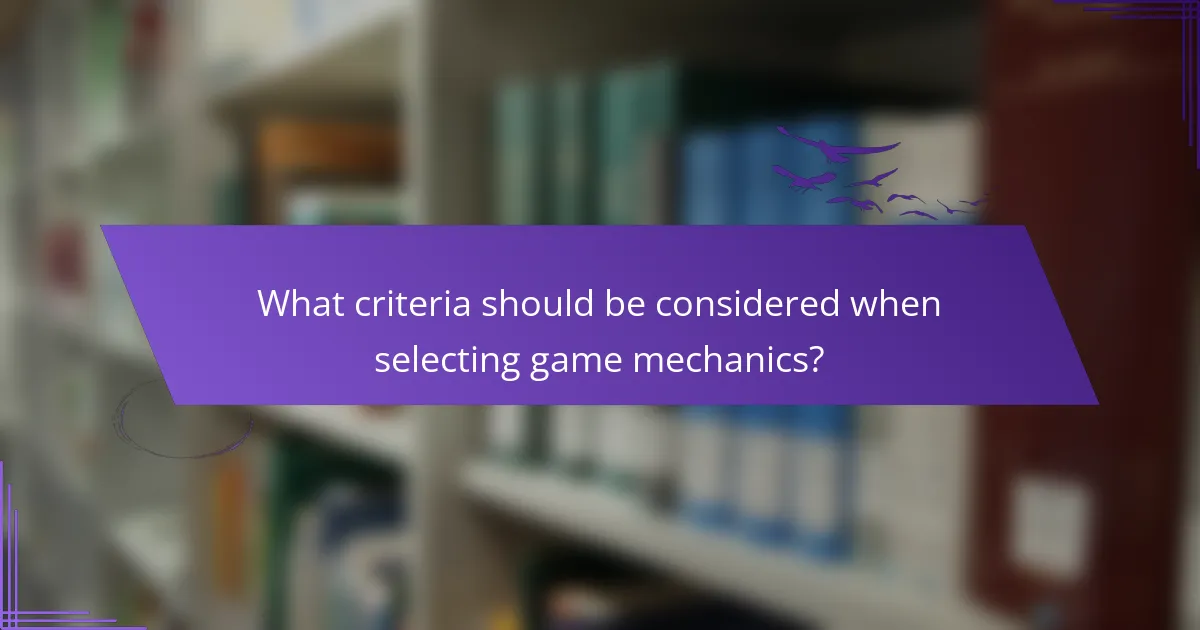
What criteria should be considered when selecting game mechanics?
When selecting game mechanics, consider how they align with educational goals, the preferences of the target audience, and the technical capabilities of the course platforms. These criteria ensure that the chosen mechanics enhance learning and engagement effectively.
Alignment with learning objectives
Game mechanics should directly support the learning objectives of the course. For instance, if the goal is to develop critical thinking skills, mechanics that encourage problem-solving and decision-making are essential. Assess whether the mechanics promote active participation and reinforce key concepts.
Consider using mechanics like point systems or badges to motivate learners while tracking their progress. This alignment helps maintain focus on educational outcomes and ensures that gameplay enhances rather than distracts from learning.
Target audience preferences
Understanding the preferences of your target audience is crucial when selecting game mechanics. Different demographics may respond better to various styles of gameplay; for example, younger audiences might prefer fast-paced, competitive mechanics, while older learners may appreciate collaborative or narrative-driven experiences.
Conduct surveys or focus groups to gather insights on what types of mechanics resonate with your audience. This feedback can guide the selection process, ensuring that the game mechanics are engaging and relevant to the learners’ interests.
Technical feasibility for course platforms
Evaluate the technical feasibility of implementing chosen game mechanics on your course platforms. Some mechanics may require advanced technology or software that is not compatible with all learning management systems (LMS). Ensure that the selected mechanics can be integrated smoothly without excessive costs or technical hurdles.
Consider factors such as platform capabilities, user accessibility, and support for multimedia elements. A well-planned technical approach can prevent future complications and enhance the overall learning experience.

What are the benefits of game mechanics in education?
Game mechanics in education enhance learning experiences by increasing student engagement and motivation while developing essential skills. These mechanics create interactive environments that encourage participation and collaboration among learners.
Enhanced motivation and engagement
Game mechanics significantly boost motivation by incorporating elements like rewards, challenges, and competition. When students earn points or badges for completing tasks, they feel a sense of accomplishment that drives them to engage more deeply with the material.
For example, a classroom might use a point system where students earn points for participation, which can be redeemed for small prizes or privileges. This tangible reward system can lead to higher levels of enthusiasm and commitment to learning.
Development of critical thinking skills
Game mechanics often require players to solve complex problems and make strategic decisions, fostering critical thinking skills. By navigating challenges and adapting to changing scenarios, students learn to analyze situations and develop effective solutions.
Incorporating puzzles or scenario-based challenges in educational games can help students practice these skills in a low-stakes environment. For instance, a science simulation game might require students to experiment with different variables to achieve a desired outcome, enhancing their analytical abilities.
Fostering collaboration among learners
Many educational games are designed for teamwork, encouraging collaboration among students. This cooperative gameplay helps learners develop communication skills and learn to work effectively with others toward a common goal.
Group-based challenges, such as escape rooms or team quests, can be implemented in classrooms to promote collaboration. These activities not only build social skills but also help students appreciate diverse perspectives and approaches to problem-solving.
